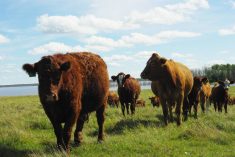Reuters — The U.S. hog herd in the March-May quarter rose two per cent to a record high versus a year ago, according to Friday’s U.S. Department of Agriculture report, which exceeded most analysts’ forecasts.
Farmers added to their herds due to affordable feed, strong U.S. pork export demand and gradual price improvement for their animals, analysts said following the report.
Producers became increasingly confident about their expansion plans as hogs recovered from the porcine epidemic diarrhea virus (PEDv) that killed an estimated 8 million pigs over the past three years.
Read Also

U.S. grains: Soy futures post biggest monthly gain in nearly five years on China trade optimism
U.S. soybean futures climbed to a 15-month high and posted their biggest monthly gain in nearly five years on Friday following a rally fueled by the prospect of revived exports to China.
Some analysts said Friday’s government survey suggests weaker hog and pork prices through the remainder of 2016 versus a year ago.
The USDA report showed the U.S. hog herd as of June 1 at 102 per cent of the year-ago level or 68.381 million head. It surpassed the record high of 67.166 million for the same period last year.
Analysts, on average, expected 67.695 million head, or 100.8 per cent of the year-earlier herd.
The U.S. breeding herd was 101 per cent of the year-ago level, at 5.979 million head, up from 5.926 million last year.
The average trade forecast was 5.951 million or 100.4 per cent of the previous year.
The June 1 supply of market-ready hogs for sale to packers was 102 per cent of a year earlier at 62.402 million head, an increase from 61.2 million last year. Analysts, on average, looked for a 0.8 per cent gain, or 61.722 million.
Analysts viewed Friday’s data as bearish for Chicago Mercantile Exchange lean hog futures on Monday. Futures settled lower on Friday, partly on worries over Britain’s break from the European Union.
“The reality is we had more hogs than we thought and we’re going to have bigger numbers coming at us in the third and fourth quarter than anticipated,” said U.S. Commodities analyst Don Roose.
Farmers appeared more optimistic with virus less of a factor than in previous quarters, said Roose.
He added that one of biggest issues the hog industry wrestled with from 2005 to 2012 was high feed costs, which have now become more reasonable.
Bob Brown, an independent market analyst, cited the record pigs per litter and a 1.5 percent bump in the number of sows that had pigs, as key drivers for expansion in Friday’s report.
Additionally, he pointed to increased chatter about U.S. pork exports to China after their prices hit record highs, which motivated domestic producers.
— Theopolis Waters reports on livestock markets for Reuters from Chicago.











